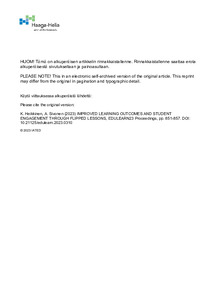IMPROVED LEARNING OUTCOMES AND STUDENT ENGAGEMENT THROUGH FLIPPED LESSONS
Heikkinen, Katri; Sivonen, Anna (2023)
Heikkinen, Katri
Sivonen, Anna
IATED, International Association of Technology, Education and Development
2023
All rights reserved. This publication is copyrighted. You may download, display and print it for Your own personal use. Commercial use is prohibited.
Julkaisun pysyvä osoite on
https://urn.fi/URN:NBN:fi-fe2023081696941
https://urn.fi/URN:NBN:fi-fe2023081696941
Tiivistelmä
While using flipped learning the learning of the content is done outside the classroom, through individual tasks and assignments. The contact lessons are then used to apply this knowledge for problem solving and other such activities. Using flipped learning or flipped classroom teaching has been shown to have many benefits, such as an increase in student engagement and a positive attitude towards the learning in general. Flipped lessons taught by students are more interactive and fun, and students are more productive and enthusiastic about the class. For many, peer instruction is an effective way to learn a subject as one really needs to internalize the content to be able to explain it to others in a convincing and understandable way. In addition, it provides the teachers with the opportunity to focus on really demanding issues.
The purpose of this paper is to illustrate how a well-planned usage of flipped learning in one course creates synergy effects, benefits and engagement beyond that one course. This paper describes one example of how we have utilized flipped learning as teaching method in Haaga-Helia University of Applied Sciences Porvoo Campus in Finland when teaching students different service design tools. We explain how the four pillars of flipped learning (Flexible environment, Learning culture, Intentional content, and Professional educators) are shown in our implementation and evaluate how flipped learning can be used as a part of inquiry-based learning. We want to share our best practices and feedback that we have received while implementing flipped learning in our course.
The results of the students have been incredibly good, and they see the flipped learning as eye-opening and engaging in many ways. During the course they get to know new service design tools, which they can apply directly in their project running at the same time in another course. In addition, they get more understanding for teachers as they see the other side of the coin when acting as instructors in one session, as well as increased team working and problem-solving skills. This can also be seen in the course feedback, where students indicate this with high grades especially in the active participation in studies and the study method and environment supporting the learning.
The purpose of this paper is to illustrate how a well-planned usage of flipped learning in one course creates synergy effects, benefits and engagement beyond that one course. This paper describes one example of how we have utilized flipped learning as teaching method in Haaga-Helia University of Applied Sciences Porvoo Campus in Finland when teaching students different service design tools. We explain how the four pillars of flipped learning (Flexible environment, Learning culture, Intentional content, and Professional educators) are shown in our implementation and evaluate how flipped learning can be used as a part of inquiry-based learning. We want to share our best practices and feedback that we have received while implementing flipped learning in our course.
The results of the students have been incredibly good, and they see the flipped learning as eye-opening and engaging in many ways. During the course they get to know new service design tools, which they can apply directly in their project running at the same time in another course. In addition, they get more understanding for teachers as they see the other side of the coin when acting as instructors in one session, as well as increased team working and problem-solving skills. This can also be seen in the course feedback, where students indicate this with high grades especially in the active participation in studies and the study method and environment supporting the learning.
